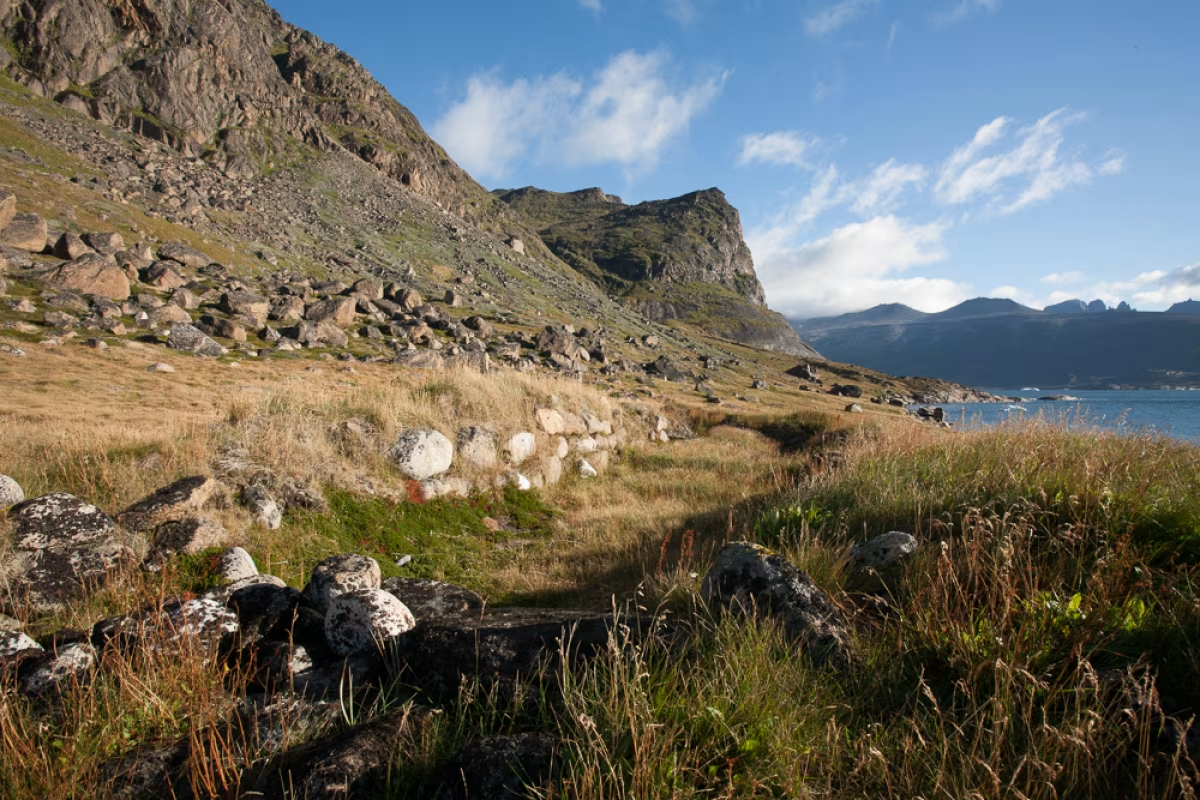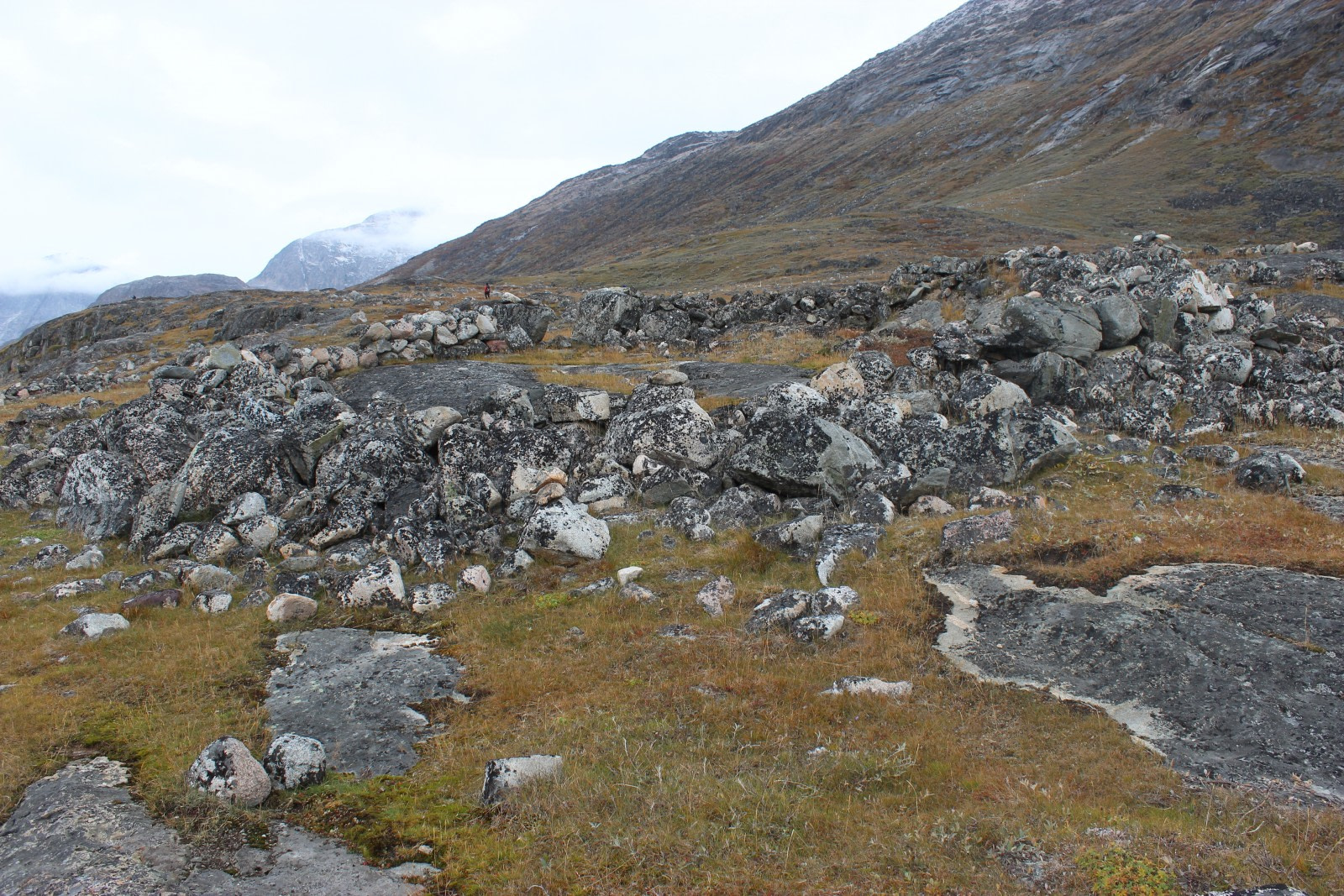The Norse Settlement of Greenland and their discovery of North America
Erik the red is a very colourful and important figure in the history of the Norse Vikings. The source for his story is found in the Icelandic Sagas Huaksbók (14th Century) and Skalhóltsbók (15th Century). These two accounts contain somewhat different versions of what happened 3-400 years earlier. The original saga of Erik the Red is believed to have been written around 1200 A.D. and the version in Skalhóltsbók is believed to be most true to the original. Also Flateyjarbók (13th Century), which contains the Saga of the Greenlanders, is an important source that helps to understand the settlement of Greenland and the discovery of Vinland – North America.
Erik the Red exploring new land
Erik the Red grew up in Norway where he was implicated in some murder cases. Along with his father he migrated to Iceland where he settled on the central west coast of Iceland and married Thjodhild. However in Iceland Erik was involved in further disputes and killings which resulted in his being proclaimed an outlaw and sentenced to three years banishment. He left Iceland around the year 982 A.D. heading forland he’d heard of lying to the west, spotted by a man called Gunnbjörn about 100 years earlier. Erik’s Greenland expedition carried him further southwest and around Cape Farewell, the southern tip of Greenland. He then sailed onward, moving north exploring the many fjords and finding lush green pastures which were more fertile than Iceland.” For at least two years he investigated the new land including the places that are now known as the Eastern Settlement and the Western Settlement.
Greenland settled by the Norse Vikings
Returning to Iceland after three years he spoke about the new land he called Greenland and tried to find people willing to start up a settlement there. The sources say that this happened 15 years before Christianity became law in Iceland pinpointing it at around 985 A.D. Erik succeeded and gathered a fleet of some 25-30 ships with around 700 settlers. Only 14 ships arrived. The new settlements were named after the founders as for example Erik’s own farm Brattahlid, deep inside Eriksfjord (nowadays Tunugdliarfik), just across from modern day Narsasuaq.
Hundreds of archaeological finds found primarily in the southwest suggest that their settlements lasted for more than 500 years. The settlements disappeared however and no one really knows why. The last documented event recorded concerning the Greenland settlers is a high society wedding in Hvalsey Church in 1408 between Sigríður Björnsdóttir and Þorsteinn Ólafsson both of whom had arrived in Iceland in 1410. Since then it is unknown what became of the Norse settlers in Greenland. Suggested theories for the demise of the settlements include a suddenly colder climate or perhaps the opening of new trade with dried cod from North America creating a better living elsewhere.

Hvalsey Church | © Troels Jacobsen - Oceanwide Expeditions
The Saga of the Greenlanders
After Eric the Red settled in Greenland traffic between Norway, Iceland, and Greenland was established. It led to an accidental journey that may have been the first Viking contact with North America.
Bjarni Herhjólfsson, the first Viking to discover North America, is only mentioned in the Saga of the Greenlanders. The story goes that he used to alternate his overwinterings with his father between Iceland and Norway. One time upon arriving in Iceland he found his father had migrated to Greenland and decided to follow him on this very dangerous voyage. Bjarni’s ship encountered unfavorable weather with fog and north winds and Bjarnilost his bearings. It took several days before the weather turned for the better and Bjarni found himself near land with woods. Bjarni realized that this wasn’t Greenland and he did not land. He spotted land twice more but these locations also did not follow the description of Greenland that he had heard and he continued onward. Bjarni and his ship eventually reached Greenland and he settled in Herjolfsnes in the southwest of the country not far from modern day Narsaq Kujalleq. Herhjolfsnes became a major hub for the trade going between Greenland and Iceland and is the only settlement mentioned on the famous Skálholt Map from 1570 of the north Atlantic region as the Norse understood it.
Bjarni’s exploits are only mentioned in the Saga of the Greenlanders and nowhere else. Just as the case may be with the different versions of Erik the Reds’ Saga in Huaksbók, Bjarni’s story may have been edited by descendants of Erik the Red, whose son Leif Eriksson later has been accredited with the discovery of North America. Perhaps this was a case of history being rewritten to enhance family members’ exploits.

Herhjolfsnes | © Troels Jacobsen - Oceanwide Expeditions
According to the Saga of the Greenlanders Leif Eriksson became intrigued by the story of Bjarni. He bought Bjarni’s ship and took advice from him and then set sail towards the west from Herhjolfsnes. On this journey Leif discovered new land on three separate occasions. First a cold and icy land to the north which he called Helluland or Stone-slap land, later interpreted as being Baffin Island, Canada. He then sailed further south and encountered a landscape full of forests which he called Markland which is thought to be the Labrador coast which is dominated by Taiga forest. Last but not least he landed at Vinland which today is interpreted as Newfoundland. Interestingly it is not believed that vines and grapes could grow in Newfoundland at the time. Hence it is odd that the name Vinland (“Wine land”) had taken such a hold. It is however not a modern interpretation of a word as the 11th Century monk Adam of Bremen also mentioned grapes and vines. It may well be that it was not grapes that was meant but rather Gooseberries which in the times of the Icelandic sagas were called Vínber or “Wine-berries”, leading to the name.
Follow in the footsteps of the earlier Norse settlers
Join us on an expedition cruise to southwest Greenland and follow in the footsteps of the earlier Norse settlers. Experience Erik the Red’s farms, the remains of the famous settlement in Gardar, the Hvalsey Church ruin built around 1300 A.D, Herjolfsnes, and discover the reason why Erik called the new land Greenland. The landscape is spectacular, and the history intriguing. Along the way we have plenty of chances to see humpback whales as we sail these fabled waters.

